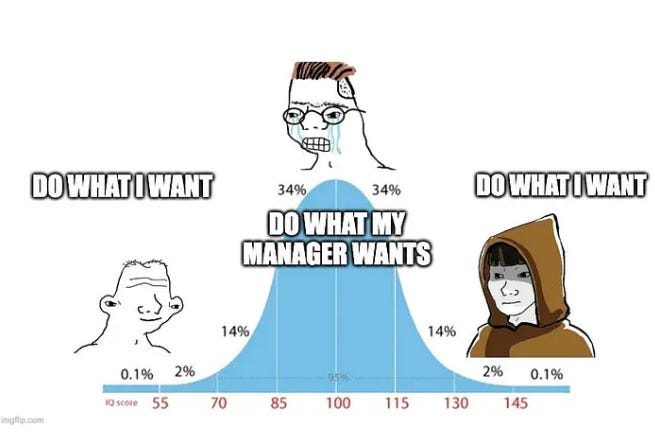To become a more trusted designer, ask your team more questions
Designers may know “How” and “What”, but they often don’t know “Why”

“How do you know when to speak up?” A timid designer asked me about a theme I’ve noticed more and more.
Currently, many Designers are terrified and unwilling to rock the boat. They’re afraid they’ll be out of a job and back on the nightmarish market if they make too much noise or slow things down.
Unfortunately, this results in substantial power imbalances between Product, Executives, and Designers.
They watch Engineers make random changes to their designs or Product teams shoot down any suggestions to “improve things beyond the MVP.”
It’s a valid fear: right now, the value of Designers is in question, and even some of the most brilliant designers I know are looking for jobs.
However, you can still learn to push back and do what’s right if you can answer a single question: “Will these actions further the team’s interests?”
The Valuable employee paradox and going beyond opinions
Julie Zhuo, former VP of Design at Meta, recently released the “Valuable Employee Paradox” scale.
While she takes a manager's viewpoint, the scale she introduces showcases the power of going beyond opinions.
It consists of 3 types of people that fall into different categories:
The worst reports: they do what they want that act against the team’s interests (They’ll miss deadlines to play a videogame)
The average reports: they follow everything the manager says (i.e. “Yes Boss, I’ll build what you ask for without question)
The best reports: they do what they want to further’s the team’s interests.
In other words, the most valuable employees are the ones who act similarly to those who are the first to get fired.
The clearest example of this comes from the TV Show, House MD. If any other doctor behaved the way that House does, they’d be terminated and perhaps sued.
However, because House solves medical cases, no one else can (i.e., he furthers the hospital's interest), people listen to him, respect him, and even tolerate his antics.
But you don’t need to become a genius to become a valuable employee who designs meaningful, impactful products.
All you need to do is ask the right questions.
The power of being effective instead of efficient
You’ve heard the stories of Abraham Lincoln sharpening the axe. You’ve heard that preparation is key to success.
But many designers, when you hear product requirements, jump straight to sketching things out in Figma.
That’s trying to be an ‘efficient designer’. The idea is simple: you start designing to turn around screens in 2–4 weeks, and every second seems to count.
You know you should be taking your time to understand the problem. But you’ve seen UX colleagues who take that time get laid off.
They spent time generating design artifacts and working on flow charts, and then, 4 weeks later, nothing was designed.
Then the business laid them off, maybe because it seemed like they were going against the team’s interests (i.e., they’re a terrible report).
Some managers might have thought, “We’re trying to meet deadlines here, and all this person does is slow things down without delivering here.” So, they’re gone, and now you’re in that person’s place.
It’s not a great situation, but there’s one thing you can always do in that situation: ask questions.
By far, the #1 thing designers never do enough is ask questions. Many designers are too polite for their own good, saying that asking questions is “too rude” or “too uncomfortable” or they “want to try and figure it out themselves.”
But if you do that, you’re forced to become an efficient designer who works long hours and is stressed by deadlines. Why? Your first iteration might only be 20% there, so you must design quickly and iterate.
But if you spend an extra hour or two asking all the questions you need to get started before ever sketching something out, you might understand 80% of the questions and be able to create high-quality work in less time.
If you’re still uncomfortable, tell your Product Manager something like this: “You’re going to get the designs in (x) weeks, but the more I understand the Product, the better it’s going to be.”
That will get a meeting on the books.
Then, you only need to ask a few types of questions.
The most important question isn’t one you expect
The most important question to ask PMs isn’t what you might expect. It’s
“How do you define success for this project?.”
Why does this matter? You cannot effectively run the race without ever knowing the finish line. Let’s talk about what that means.
Imagine you were asked to design a way to “sort and filter” a whole bunch of results on a page. Let’s say this is part of some insurance process.
Some designers might hear that, decide this means “design a table,” and start assembling a design pattern.
However, depending on what “success” means to the project, that could be the wrong approach. Why?
If you ask your Product Manager about success, and they say “We’re prioritizing accuracy. It’s successful when the user never chooses the wrong option.”
Then, is having a huge unsorted table the user needs to dig through the right approach? Probably not.
But until you have a clear definition of what “success means” to the business, it’s hard to design the right option.
This transitions into the next important question.
Ask about Data, even if you don’t understand it
There’s a related question about success is often the perfect followup:
What metrics are used to define success?
While I know what that means because of Data-informed Design, it’s worth asking that question even if you don’t understand metrics. Why? Because it touches on one important factor:
“Why is this currently a problem?”
This is often a critical piece of knowledge that businesses think designers don’t need to know about. However, understanding this helps you understand your team's desired outcome and the actions you should take to further them.
For example, the answer might be, “Because our task error rate is 39%”.
By asking and understanding this question, you understand the user behavior that needs to change.
This is what you’ve uncovered with these two questions:
The most important measurement for this project is about “Completing this task without error.”
Right now, the users are making a lot of errors during this insurance process
Therefore, the top priority with my designs, is to reduce errors
This helps because then you know your design decisions should be based around “reducing potential errors.”
If additional information might help, but users are making a lot of errors with the section, you might make that entire section optional (or de-emphasized).
After this, there are just a few more questions to consider.
Make sure you have a clear understanding of Why
While I won’t provide an entire interview script, other questions you should ask should be centered on answering a single question: “Why are we doing this right now?”
For example, here are some other questions you might want to ask just to ensure that you have a clear understanding:
What’s the history/context of the project?
What are known constraints/challenges for the project?
What do you know about our primary users that might be helpful?
What does success look like post-launch?
etc.
The primary purpose of all these questions isn’t to ask design questions like “What size font should we use?” or “What interactions do we need to account for.” It’s simply to understand the Why, which is often the critical piece missing to take the right action.
Do the right thing in a way that helps your team
One of the things I’ve learned working in Healthcare UX is that sometimes you can’t follow the ‘letter of the law’ when it doesn’t understand UX (I haven’t broken any laws, FYI).
I don’t have time to wait 3 months to get proper approval for a useless meeting that includes a patient, two family members, a doctor, and a lawyer.
Doctors will never have time to talk to me in a traditional “60–90 minute meeting” in an ideal meeting time and place.
This is why I’ve sat in a hospital cafeteria to strike up conversations and meet with doctors at 4 AM.
But the only reason I’ve been able to do that is because I understand the overall goal the team is working towards. To do that, you need to ask more questions.
So if you’re feeling trapped, like you can only design what your Product Manager tells you, stop. Take a minute and see if you’re asking the right questions to understand what your team is interested in.
Once you do, you’ll be able to not only work more effectively but you’ll become a valuable employee who can act in the team’s best interests.
Kai Wong is a Senior Product Designer and Data and Design newsletter writer. He teaches a course, Data-Informed Design, using data to communicate more effectively and get buy-in for your design recommendations.







"What does success mean for this project" is one of my go to questions